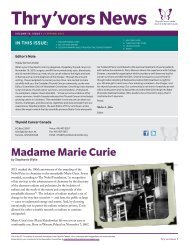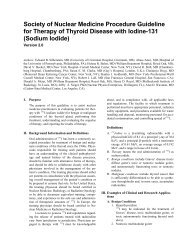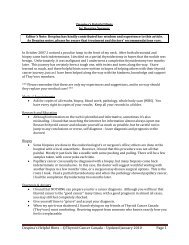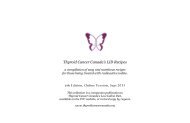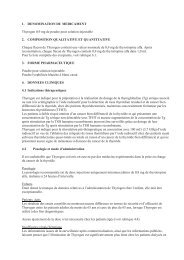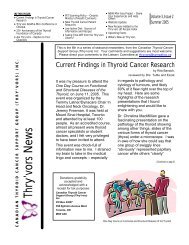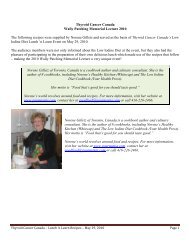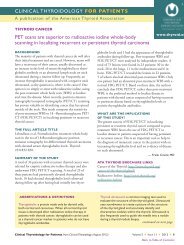Why a TCC LID? - Thyroid Cancer Canada
Why a TCC LID? - Thyroid Cancer Canada
Why a TCC LID? - Thyroid Cancer Canada
You also want an ePaper? Increase the reach of your titles
YUMPU automatically turns print PDFs into web optimized ePapers that Google loves.
foods were in fact high sources of iodine (such as dairy products and eggs) and other foods wererestricted for no apparent reason.In 2006, with the help of over 30 experts in the fields of medicine, nutrition, government and thepackaging industry, we developed a definitive and reliable Low Iodine Diet.In 2009, we revised and improved the resource. We have now consulted with over 80 experts,including those in the food industry, associations, government, etc. A list of the <strong>TCC</strong> reviewers isavailable as a separate document entitled “<strong>TCC</strong> Low Iodine Diet 2009, References, Writers & Reviewers”available at www.thyroidcancercanada.org.Q2: Is a <strong>LID</strong> Necessary?My doctor said it’s not necessary to go on the <strong>LID</strong> and/or my doctor did not mention the <strong>LID</strong> tome. Is the diet necessary for a successful radioactive iodine treatment (RAI)?A: Studies since the mid-1960’s that have investigated use of the <strong>LID</strong> in preparation for RAIgenerally conclude that using the <strong>LID</strong> for two weeks prior to RAI will improve the efficacy of thetreatment.In 2010, Sawka et al examined and reported on more than 75 studies on the topic of the <strong>LID</strong>. Theauthors report that the overall evidence indicates that a <strong>LID</strong> does reduce urinary iodine output and thattwo weeks on the diet is about twice as effective as one week. Albeit small studies, at least tworesearch teams, convincingly found that a <strong>LID</strong> increases uptake of I-131 and ablation of remnant tissueor tumours. Although Sawka et al state “unfortunately, there are still no studies examining long-termrecurrence or mortality rates in patients treated with an <strong>LID</strong> compared to an unrestricted diet”, they doconclude that there is compelling evidence that a <strong>LID</strong> should be utilized to aid a successful preparationfor RAI treatment and scanning.Hinds et al (2008) concludes that “An <strong>LID</strong> is an integral element in the management of differentiatedthyroid cancer. Proper guidance and emphasis on the implementation of the diet needs to be providedto patients. Non-compliance may lead to false negative imaging results, misleading the medicalprofessionals and patient. Potentially inadequate management of the patient’s thyroid cancer mayfollow.”References:Hinds, S.R., Stack, A.L and Stocker, D.J., (2008), “Low-iodine Diet Revisited. Importance in Nuclear Medicine Imaging and Management.Clinical Nuclear Medicine, 33(4), p. 247 – 250.Sawka AM, Ibrahim-Zada I, Galacgac P, Tsang RW, Brierley JD, Ezzat S, and Goldstein DP, Dietary Iodine Restriction in Preparation forRadioactive Iodine Treatment or Scanning in Well-Differentiated <strong>Thyroid</strong> <strong>Cancer</strong>: A Systematic Review, THYROID, 2010 October; 20(10): 1129–1138Q3: How long should I be on the <strong>LID</strong>?A. <strong>TCC</strong>’s research indicated that 2 weeks before ingesting the RAI dose, and 1-2 days after ingestingit, is an adequate length of time for patients undergoing RAI treatment or scans in order for an effectiveresult of the diet.References: as above, andwww.thyroidcancerdoctor, Entry: Urinary Iodide Testing - <strong>Thyroid</strong><strong>Cancer</strong>Help, August, 2007 and How long on <strong>LID</strong> post RAI? -<strong>Thyroid</strong><strong>Cancer</strong>Help, June, 2007© <strong>Thyroid</strong> <strong>Cancer</strong> <strong>Canada</strong> – 28-Feb-122



